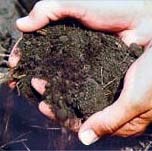

 |
Have you ever noticed the different textures in soils? Rub some soil between your finger and thumb to see. Try this in different areas as a comparison. Textures come mainly from the size and amount of mineral particles present in the soil. For example, if you try picking up a handful of a sandy soil, you will notice that it feels ‘gritty’. This is because it is made up of large mineral particles. Compare this to a handful of clay soil, which feels sticky to touch when wet because it has finer particles which can hold more water. Silty soils lie in composition between sandy and clayey ones and have a smooth somewhat velvety feel to them. Organic matter, also called humus, believed by many to be the most important constituent of soils, is partially-decomposed organic material, rich in nutrients, which is essential to the fertility of soil (or how fruitful and productive it is). You can often tell how much organic matter there is in soil by looking at how dark it is – the darker the soil, the greater the concentration of organic matter. |
|
|||
|
|
|
|||
